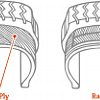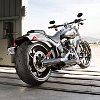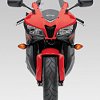Our Why Things Are the Way They Are series continues with a topic that has sparked more than a few heated debates: tires. Radial tires have proven results on and off the racetrack. So, why are bias-ply tires still hanging around the motorcycle world?
There are some good answers to that question, but before we get into them, let's define the terms we're using.
Tire construction, bias-ply vs. radials
If you’re a total rookie to tires, be sure to check out our Motorcycle Tires 101 guide. In the interest of keeping this article brief, we’re going to assume you have a rudimentary idea of how tires are constructed.
Bias-ply tires were the de facto standard for many years. Bias-ply tires lay down their body cords (typically made of a fabric like nylon, rayon, or polyester) from bead to bead, running across the tire in alternating layers.
Radial tires, which came onto the scene in the 1980s, are made differently. Their body cords run across the tire radially — directly from bead to bead. Typically, those body cords are made of steel. Atop those first thin layers, alternating layers of body cords are stacked in the tread portion of the tire only, so the sidewalls aren't as thick as they are on a bias-ply tire.

Benefits of construction types
Radial tires were an attempt to correct some unwanted characteristics of bias-ply tires. Bias-ply tires do not shed heat quickly, for starters. As motorcycles became faster and faster, the tires were limiting how quickly the riders could ride them. The bikes were capable, but the tires of the day couldn’t go the distance. Radial tires’ steel belts dissipated heat better.
The second problem is that bias-ply tires have a very stiff sidewall due to the fact that all the plies run from sidewall to sidewall. Because radial tires have fewer layers of body cords on the sidewall, the sidewalls allow the tire to flex more. This means the contact patch of the tire stays put on the ground a bit better, and the sidewall provides lots more feedback to the rider. This design also allows the sidewall and tread to work more independently of each other than a bias-ply permits.
So why ain’t err’body on radials?
Sportbike folks are usually interested in performance, which means speed. They need tires that can hold together under extreme stresses. Touring riders typically are interested in performance, which means load-carrying capacity and longevity. They need tires that can hold together under heavy burdens.
Happily, there's a method of tire construction that shines for each! Bias-ply tires’ stiff sidewalls perform admirably under heavy loads. Their inherent lack of flex also means the sidewall won’t "wash out" in a turn as easily as a radial. When motorcycles come out of the factory with bias-plies and radials mixed, the bias-ply is always in the front. Often, it’s on a bike with a skinny, large-diameter hoop up front, like an FX-style Harley, backed up by a wider-than-130 rear tire.

Bias-ply tires are also the only tube-type tire available. Many riders like the classic look of spoked wheels, and in off-road situations, spoked wheels are usually a little more sturdy and wheel damage is not always catastrophic, as it usually is with cast wheels. Different manufacturers have different positions on adding tubes to radials, but such a setup is usually not ideal.
Radial tires, as we discussed, dissipate heat better and allow better sidewall flex. Another issue related to their construction is the ability to create a tire that has substantially larger tread than sidewall. On bias-ply tires, the width of the tread and the height of the sidewall are typically similar. Radial construction, though, allows those two dimensions to be substantially different. What does that mean? It means something like an extra-wide tire — say a 300-series — can be made without a crazy-tall-looking sidewall. Those of you interested in Y2k-era choppers really have radials to thank for that whole look. Wide rears could not happen with bias-ply tires.

Recap (not retread)
Just as a heavy touring bike and a 600-class sportbike have different goals, purposes and strengths, radial and bias-ply motorcycle tires have different strengths and excel at different tasks. The question isn’t so much which tire is better, but rather which tire is better for the application.































 Riders Preferred Membership
Riders Preferred Membership



